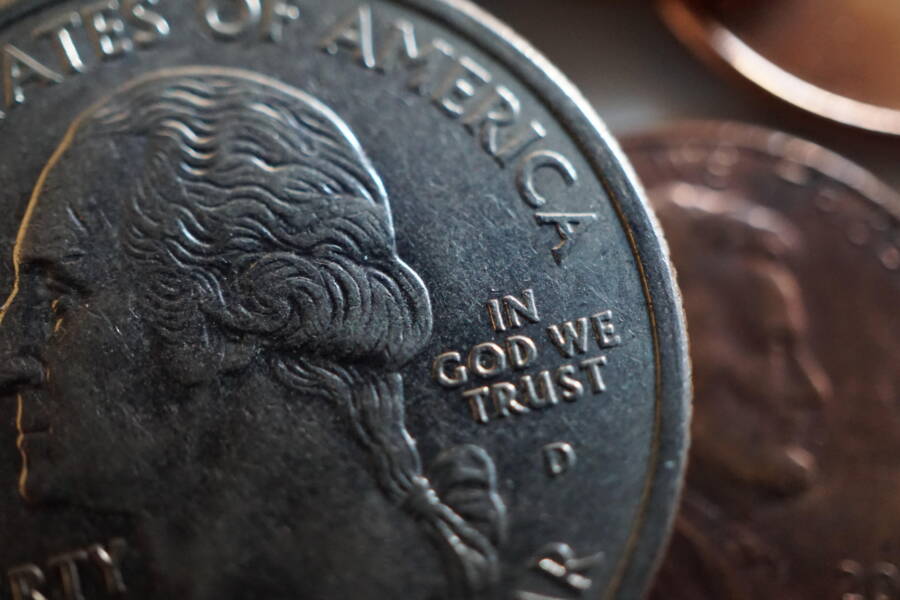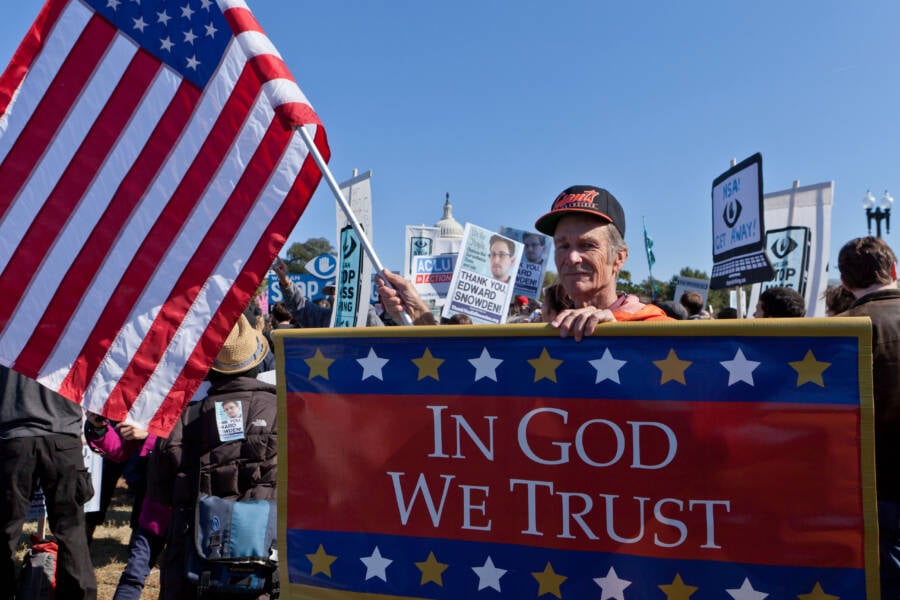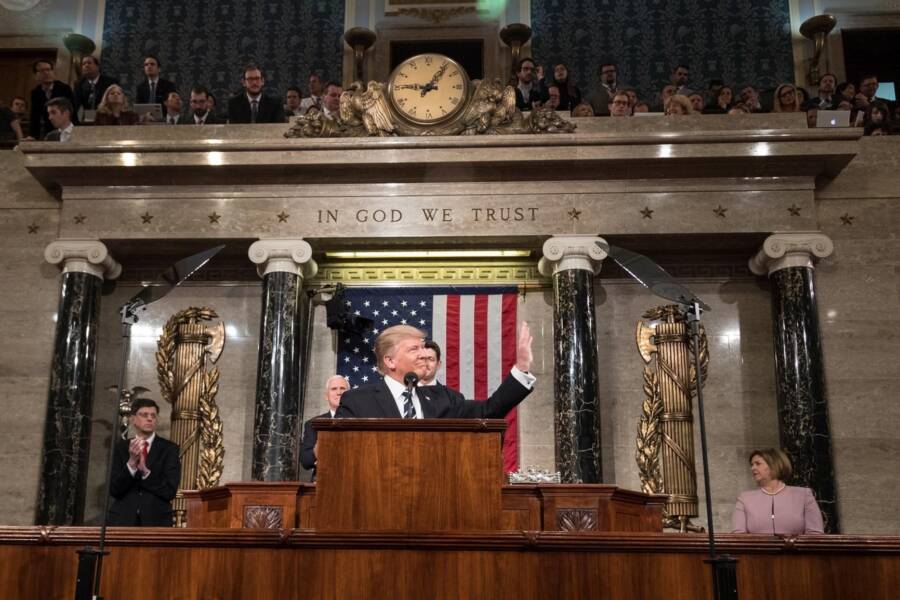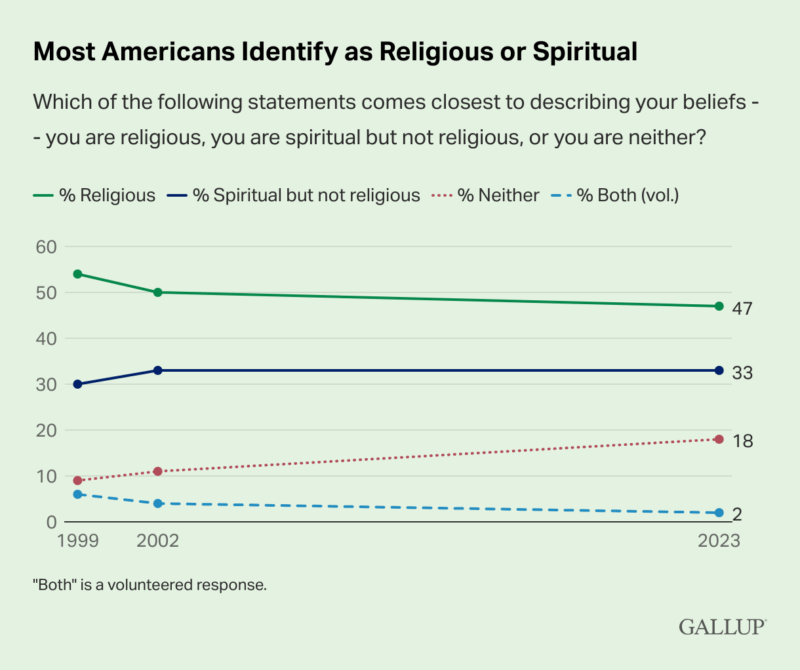The phrase "In God we trust" has appeared on all American currency since 1957, but its controversial history goes back much further than that.

Jason Hawkins / Alamy Stock PhotoA close-up of the inscription “In God we trust” on a quarter.
The phrase “In God we trust” is all but inescapable in the United States. It is pressed on coins, printed on dollar bills, and, in many states, present in every classroom. But for a country that purportedly separates church and state, why adopt a national motto that harkens back to Christianity?
Even more perplexing is that this motto, officially adopted in 1956, replaced a much more secular one, E Pluribus Unum, or “Out of many, one,” which had served as the de facto phrase prior to the change.
Like many things in America, the switch was the result of a complex set of historical circumstances dating back to the Civil War, with the added paranoia of the Cold War providing a new desire for Americans to separate themselves from the atheist, communist Soviets.
But that’s not all there is to this story. Discover the real history of America’s complicated relationship with the motto “In God we trust.”
When Was “In God We Trust” Added To Money?
The motto “In God we trust” was inspired by the fourth verse of America’s national anthem, “The Star-Spangled Banner.” The line reads: “Then conquer we must, when our cause is just, and this be our motto: ‘In God is our trust.'”
This dedication to the Almighty became highly influential for the proud patriots of early America. But according to the Pew Research Center, the first official use of “In God we trust” came 50 years later.

National Park ServiceA depiction of the bombardment of Fort McHenry, the War of 1812 battle that inspired Francis Scott Key to pen “The Star-Spangled Banner.”
In 1861, a Christian minister named Reverend M. R. Watkinson of Ridley Township, Pennsylvania, penned a letter to Secretary of the Treasury Salmon P. Chase petitioning for “the recognition of the Almighty God in some form on our coins.” In part, Watkinson’s suggestion was intended to improve the morale of Union soldiers, assuming that if they had the blessing of God on their side, they would prevail in the war. What’s more, Union states wanted to display what they truly stood for to the outside world.
Chase found some sense in the reverend’s words, and he put out an order for the U.S. Mint to begin producing coins with a religious reference on them. Initially, the director of the Mint suggested the phrase “God, Our Trust.” Chase then changed it to “In God we trust,” and the motto began appearing on Union currency in 1864, beginning with a two-cent coin.
“In God we trust” was added to coins with room for the phrase one year later. Soon, however, paper money became increasingly popular — but it wasn’t until the mid-1950s that “In God we trust” was added to bills.
“In God We Trust” Becomes The Official Motto Of The United States
After the Civil War, the United States saw a rise in secularism. As a result, many Americans started to believe that using religious language in a governmental context was inconsistent with the values of the country.
In the 1950s, however, Americans found themselves increasingly wary of anything reminiscent of the Soviets and communism.
Given that the Soviet Union was aggressively atheist, the American pushback to this ideal gave way once more to a rise in religion. Americans were less averse to using religious language in governmental settings, and so, in 1956, President Dwight D. Eisenhower signed a bill making “In God we trust” the official U.S. motto and requiring it to appear on all American currency.
Democratic Congressman Charles E. Bennett of Florida sponsored the bill, stating that the United States “was founded in a spiritual atmosphere and with a firm trust in God.”

Wikimedia CommonsPresident Dwight D. Eisenhower signed the bill ordering that “In God we trust” was added to money.
Of course, this decision was not met with universal praise. While many religious Americans were happy to put the phrase on government buildings and currency as a show of faith and opposition to Soviet ideals, some non-Christian Americans — whether atheist, agnostic, or of another religious denomination — considered the use of such language a slight against the Constitution.
Even today, the use of the phrase “In God we trust” can be controversial.
The Controversy Surrounding “In God We Trust”
One major opponent of the phrase “In God we trust” in recent years has been Princeton University professor Kevin M. Kruse, whose book One Nation Under God casts a critical eye on the use of the phrase.
In his book, Kruse acknowledges the various ways in which Eisenhower attempted to revolutionize religion in American society during his presidency. For example, Eisenhower is the only president in U.S. history to be baptized while in office. He also had a close friendship with the evangelist Billy Graham, who was widely considered to be “among the most influential Christian leaders.”
Eisenhower also instituted the National Prayer Breakfast and began his Cabinet meetings with prayer. When Congress added the words “under God” into the Pledge of Allegiance in 1954, Eisenhower was a strong proponent.

B Christopher / Alamy Stock PhotoA man holding an “In God we trust” banner at an NSA protest rally.
All this is to say that Eisenhower strongly believed that America was, at its core, a spiritual nation. Moreover, he used religion in America as an indicator of what separated the United States from the Soviet Union.
In a 1954 radio address, Eisenhower made a point of emphasizing the purported role of religion and spirituality in American politics, saying, “Out of faith in God, and through faith in themselves as His children, our forefathers designed and built the Republic,” as reported by HISTORY.
Eisenhower’s Judeo-Christian philosophy may have resonated with many Americans at the height of a religious boom in the mid-1950s, but those ideals have been called into question several times in the decades since.
In more recent years, Eisenhower’s original sentiment that the phrase “In God we trust” is representative of American values has been a GOP rallying point, particularly during the Trump presidency.

Darling Archive / Alamy Stock PhotoDonald J. Trump’s State of the Union address in 2017.
During his first State of the Union address, then-president Donald Trump invoked the phrase, saying that “faith and family, not government and bureaucracy, are the center of the American life.” In a different address, he referred to the United States as a “nation of believers.”
For some, these statements echoed their own deeply held convictions and religious beliefs, but for others, they seemed to blur the lines between religion and politics.
Mislin ultimately summarizes the issue well, writing, “‘In God we trust’ is not a motto that reflects universally shared historical values. Rather it represents a particular political, economic and religious perspective.”
How Religious Is The United States Today?
The faith the national motto alludes to has always operated on a historical ebb and flow. In the mid-1950s, American religious beliefs were reaching an unprecedented peak, but now, in the modern era, we are once again seeing a rise in secularism.
In fact, recent data from Gallup shows that all age groups are less religious than they used to be.

GallupA Gallup data chart showing how Americans identify when it comes to religion.
That said, 47 percent of Americans still describe themselves as religious, while another 33 percent say they are spiritual but not religious. Eighteen percent of American citizens, meanwhile, say they are not religious or spiritual. This data does not factor in, however, the percentage of those religious individuals who are Christian as compared to, say, Muslim, Jewish, or Buddhist.
Regardless, the overall trend shows that Americans are certainly less religious now than in the past — and perhaps that is why there has been such contention regarding the national motto.
After learning when the motto “In God we trust” was added to money, learn about the shocking origins of the “America First” movement. Or, dive into the real history of who made the American flag.





